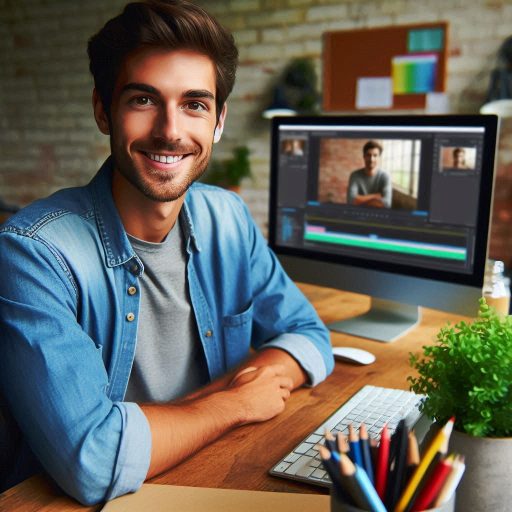Introduction
A brief overview of multimedia art showcases the combination of various forms of creative expression, such as visual arts, music, video, and more, to create dynamic and interactive works of art.
This artistic medium allows artists to explore innovative ways of storytelling and engage with their audience on different sensory levels.
The importance of workflow in creating multimedia art cannot be overstated.
A structured and efficient workflow is crucial for managing the complexity of working with multiple mediums and ensuring that the artistic vision is effectively communicated to the audience.
By establishing a clear workflow, artists can streamline their creative process, maintain consistency across different elements of their work, and ultimately bring their ideas to life in a compelling and cohesive manner.
Understanding the concept
Multimedia art is a form of art that utilizes various digital media to create interactive and engaging visual experiences for the audience.
It includes a combination of text, images, video, audio, and animations to convey a message or evoke emotions.
Define multimedia art
The term “multimedia art” refers to any artwork that uses two or more forms of media to create a piece.
This could include traditional art forms such as painting or sculpture combined with digital elements like sound or video.
Different forms of multimedia art
- Digital art: Digital art involves creating visual artwork using digital technology, such as drawing tablets, graphic design software, and 3D modeling programs.
- Animation: Animation is the process of creating moving images through a series of still frames or drawings.
It can be 2D or 3D and is commonly used in films, video games, and advertisements. - Video editing: Video editing is the process of manipulating and rearranging video footage to create a cohesive and visually appealing final product.
It involves cutting, splicing, adding effects, and adjusting audio levels.
Importance of having a clear concept
Having a clear concept before starting the creation process is crucial in multimedia art workflow.
It helps artists stay focused, organized, and ensures that their final piece effectively communicates the intended message or emotion.
- Clarity of message: A well-defined concept allows artists to convey their message clearly and concisely, preventing confusion or misinterpretation by the audience.
- Planning and organization: Having a clear concept helps artists plan their workflow, identify the necessary resources, and allocate time effectively to meet deadlines and quality standards.
- Creative direction: A solid concept serves as a roadmap for the creative process, guiding artists in making design choices, selecting media, and refining their work to achieve the desired outcome.
In essence, understanding the concept of multimedia art, exploring its different forms, and emphasizing the importance of a clear concept are essential steps in creating engaging and impactful artworks.
By combining creativity with strategic planning, artists can turn their concepts into compelling multimedia masterpieces that captivate audiences and inspire new forms of expression.
Read: Industry Tools Every Multimedia Artist Should Know
Planning your project
In order to successfully bring your multimedia art project from concept to creation, careful planning is essential.
Setting goals and objectives for your multimedia art project
- Define the purpose of your project and what you aim to achieve through it.
- Identify the target audience for your multimedia art piece.
- Set specific, measurable, achievable, relevant, and time-bound goals.
- Ensure that your goals align with your creative vision for the project.
Creating a timeline for the project
- Break down the project into smaller tasks and assign deadlines to each one.
- Consider the time needed for research, production, editing, and finalization.
- Allocate adequate time for revisions and unforeseen delays.
- Regularly review and update the timeline as the project progresses.
Establishing a budget and gathering necessary resources
- Determine the total budget for your multimedia art project, including equipment, software, and creatives.
- Research and compile a list of essential resources needed for the project.
- Explore cost-effective options and seek sponsorships or funding if necessary.
- Allocate funds for marketing, distribution, and any other project-related expenses.
By meticulously planning your multimedia art project, you can ensure that it stays on track and meets your creative goals within the set budget and timeline.
Read: How to Network in the Costume Design Industry
Gathering inspiration and research
Before diving into the creation process of multimedia art, it is essential to gather inspiration and conduct thorough research.
This phase sets the foundation for your project and fuels your creativity.
Finding inspiration from other artists and multimedia projects
- Browse through art galleries, websites, and social media platforms to discover the work of other artists.
- Observe different styles, techniques, and themes used in various multimedia projects to spark new ideas.
- Take note of elements you find captivating and consider how you can incorporate them into your own work.
Conducting research on techniques and tools for creating multimedia art
- Explore different software programs and tools that are commonly used in multimedia art creation.
- Watch online tutorials and read articles to learn about advanced techniques and innovative approaches.
- Experiment with different mediums such as digital painting, animation, video editing, and sound design.
Creating mood boards and sketches to solidify your vision
- Compile images, textures, colors, and typography that resonate with the aesthetic you want to achieve.
- Arrange these visual elements on a mood board to create a cohesive vision for your project.
- Sketch out rough ideas and layouts to visualize how your multimedia art will come together.
By immersing yourself in inspiration and taking the time to research techniques and tools, you will be better equipped to bring your multimedia art vision to life in the next stages of the workflow.
Transform Your Career Today
Unlock a personalized career strategy that drives real results. Get tailored advice and a roadmap designed just for you.
Start NowRead: Successful Multimedia Artists to Follow in 2024

Choosing the right tools and software
Popular Software and Tools Used in Multimedia Art Creation
When it comes to multimedia art creation, there are several popular software and tools that artists use to bring their concepts to life.
These tools not only help in the creation process but also enhance the overall workflow efficiency.
Here are some of the most commonly used software and tools in multimedia art:
- Adobe Creative Suite: Adobe Creative Suite is a comprehensive set of applications that include Photoshop, Illustrator, InDesign, and more.
These tools are widely used by multimedia artists for graphic design, photo editing, and illustration. - Procreate: Procreate is a popular digital painting app designed for iPad.
It offers a wide range of brushes, textures, and tools that allow artists to create stunning digital artworks. - Final Cut Pro: Final Cut Pro is a professional video editing software used by multimedia artists to edit and produce high-quality videos.
It offers advanced features like multi-cam editing, color grading, and audio mixing. - Blender: Blender is a free and open-source 3D creation suite that is used for modeling, animation, simulation, and rendering.
It is a powerful tool for creating 3D animations and visual effects. - Cinema 4D: Cinema 4D is a popular 3D modeling and animation software used by multimedia artists for creating motion graphics, visual effects, and character animations.
It offers a user-friendly interface and powerful tools for 3D design.
Tips for Beginners on Selecting the Right Tools
For beginners in multimedia art creation, choosing the right tools can be overwhelming.
Here are some tips to help you select the right tools for your project:
- Assess your needs: Before selecting a tool, assess your project requirements and determine the features you need.
This will help you narrow down your options and choose the best tool for the job. - Consider your budget: Consider your budget constraints when selecting software and tools.
There are many free and affordable options available that can meet your needs without breaking the bank. - Read reviews: Do your research and read reviews from other artists who have used the software or tools you are considering.
This can help you understand the strengths and weaknesses of each tool and make an informed decision. - Take advantage of trial versions: Many software companies offer free trial versions of their products.
Take advantage of these trial versions to test out the tools and see if they meet your needs before making a purchase. - Seek recommendations: Reach out to other multimedia artists and ask for recommendations on software and tools.
They can provide valuable insights based on their own experiences and help you make the right choice.
Importance of Mastering the Chosen Tools
Once you have selected the right tools for your project, it is crucial to master them to enhance your workflow efficiency.
Here are some reasons why mastering your chosen tools is essential:
- Efficiency: Mastering your tools allows you to work more efficiently and effectively.
You will spend less time figuring out how to use the software and more time creating art. - Creative freedom: When you are proficient in your tools, you have more creative freedom to explore different techniques and styles.
You can push the boundaries of your artistic abilities and create unique and innovative artworks. - Consistency: By mastering your tools, you can maintain consistency in your work.
You will develop a cohesive style and workflow that will make your art more recognizable and professional. - Professionalism: Mastering your tools demonstrates professionalism and dedication to your craft.
Clients and collaborators will appreciate your expertise and trust you to deliver high-quality work on time and within budget.
Read: Behind the Scenes: Costume Design in Film
Discover More: Freelance Art Director: Pros, Cons, and Tips
Creating your multimedia art
Breaking down the project into smaller tasks
When creating multimedia art, it is essential to have a clear plan in place to ensure that the project runs smoothly and efficiently.
By breaking down the project into smaller tasks, you can tackle each aspect individually and prevent feeling overwhelmed.
This approach also allows you to focus on one task at a time, leading to better results.
Setting milestones to track progress
Setting milestones throughout the project is a great way to track progress and ensure that you are meeting your deadlines.
By setting smaller, achievable goals, you can stay motivated and see tangible progress as you work towards completing your multimedia art piece.
Milestones also allow you to assess whether you are on track or if adjustments need to be made to your workflow.
Collaborating with others if necessary
Collaborating with others can enhance the quality of your multimedia art by bringing in different perspectives and skill sets.
Whether you work with other artists, designers, or professionals in related fields, collaborating allows you to leverage the strengths of each team member and create a more dynamic final product.
Additionally, working with others can help you learn new techniques and approaches that you may not have considered on your own.
Overall, creating multimedia art requires careful planning, organization, and collaboration.
Transform Your Career Today
Unlock a personalized career strategy that drives real results. Get tailored advice and a roadmap designed just for you.
Start NowBy breaking down the project into smaller tasks, setting milestones, and collaborating with others, you can streamline your workflow and produce a high-quality multimedia art piece that showcases your creativity and talent.
Discover More: Successful Creative Directors Share Their Journey
Refining and revising your work
After you have completed your initial draft, the next step in your multimedia art workflow is refining and revising your work.
This stage is crucial in ensuring that your final piece is polished and meets your artistic vision.
Here are some key steps to consider:
Seeking feedback from peers and mentors
- Share your work with trusted peers and mentors who can provide valuable insights and constructive criticism.
- Be open to feedback and actively listen to suggestions for improvement.
- Consider different perspectives to gain a well-rounded view of your work.
Making necessary adjustments based on feedback
- Identify areas of your work that can be improved based on the feedback you receive.
- Make specific adjustments to address the feedback and enhance the quality of your piece.
- Strive to incorporate the feedback while staying true to your artistic vision.
Iterating on your work to achieve the desired outcome
- Iterate on your work by making multiple revisions to refine and perfect it.
- Take the time to experiment with different approaches and techniques to achieve the desired outcome.
- Continuously evaluate your work and make enhancements until you are satisfied with the final result.
By following these steps and actively engaging in the refining and revising process, you can elevate your multimedia art to new heights and create impactful and meaningful work.
Remember, great art is a journey of continuous improvement and growth.
See Related Content: Understanding Game Design Documentation
Find Out More: Steps to Become an Exhibition Designer
Conclusion
The importance of a well-defined workflow in creating multimedia art cannot be overstated.
A clear and organized process is essential for efficient production.
Final thoughts on the process of moving from concept to creation in multimedia art production involve the integration of creativity with technical execution.
Having a structured workflow ensures that artists can focus on their creative vision while also maintaining a disciplined approach to the technical aspects of production.
By establishing a step-by-step process, artists can streamline their work, collaborate effectively with others, and ensure timely completion of projects.
Ultimately, a well-defined workflow enables artists to bring their concepts to life in a cohesive and professional manner.
It combines artistry with practicality, resulting in high-quality multimedia art.
Through a systematic approach to creation, artists can fully explore their ideas, experiment with different techniques, and push the boundaries of their craft.
Overall, the journey from concept to creation in multimedia art production is a dynamic and challenging process that requires dedication, skill, and creativity.
With a solid workflow in place, artists can navigate this process successfully and produce compelling and innovative multimedia artworks.




